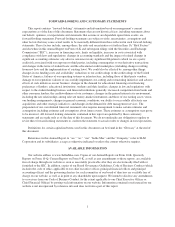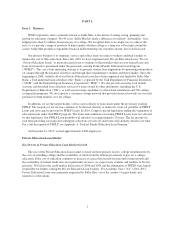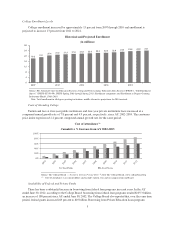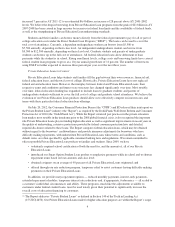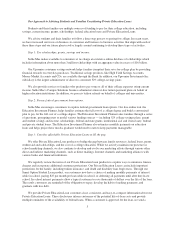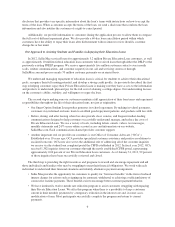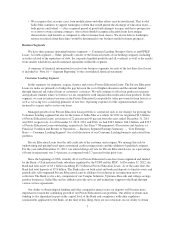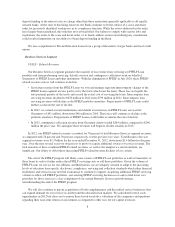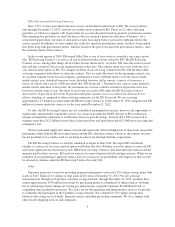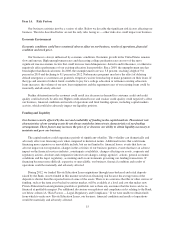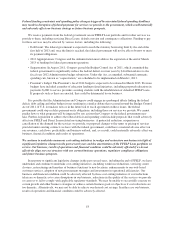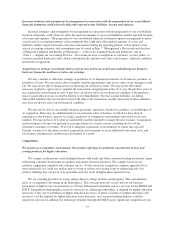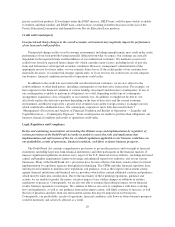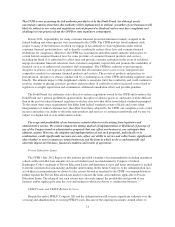Sallie Mae 2012 Annual Report Download - page 13
Download and view the complete annual report
Please find page 13 of the 2012 Sallie Mae annual report below. You can navigate through the pages in the report by either clicking on the pages listed below, or by using the keyword search tool below to find specific information within the annual report.The Consumer Financial Protection Act (the “CFPA”), a part of the Dodd-Frank Act, established the CFPB,
which has broad authority to write regulations under federal consumer financial protection laws and to directly or
indirectly enforce those laws and examine financial institutions for compliance. It is authorized to collect fines
and provide consumer restitution in the event of violations, engage in consumer financial education, track
consumer complaints, request data and promote the availability of financial services to underserved consumers
and communities. It has authority to prevent unfair, deceptive or abusive practices by issuing regulations that
define the same or by using its enforcement authority without first issuing regulations. The CFPB has been active
in its supervision, examination and enforcement of financial services companies, most notably bringing
enforcement actions imposing fines and mandating large refunds to customers of several large banking
institutions for practices relating to the sale of additional products associated with the extension of consumer
credit.
The Dodd-Frank Act also authorizes state officials to enforce regulations issued by the CFPB and to enforce
the Dodd-Frank Act’s general prohibition against unfair, deceptive and abusive practices.
Regulatory Outlook
The number and scope of regulatory and enforcement actions in 2012, as well as the amounts of fines and
penalties levied against banking institutions, were significant. The types and numbers of class and shareholder
derivative actions arising from allegations of violations of consumer protection and regulatory provisions also
continued to increase. A number of prominent themes appear to be emerging from these actions:
• The number and configuration of regulators bringing actions — often adds to the complexity, cost and
unpredictability of timing for resolution of particular regulatory issues.
• The regulatory compliance and risk control structures of financial institutions subject to enforcement
actions are frequently cited, regardless of whether past practices have been changed, and enforcement
orders have often included detailed demands for increased compliance, audit and board supervision, as
well as the use of third-party consultants to recommend further changes or monitor remediation efforts.
• Issues first identified with respect to one consumer product class or distribution channel are often applied
to other product classes or channels, as has been most notably the case in the home mortgage industry.
As noted in more detail below, in coming years we expect the regulators overseeing several of our
businesses will increase in number or change and consumer protection regulations and standards will evolve to
become more detailed in scope. We expect this evolution will significantly add to our compliance, marketing,
servicing and operating costs. While our current operations and compliance processes may or may not satisfy
heightened, evolving regulatory standards, they cannot provide assurance past practices or products will not be
the focus of examinations, inquiries or lawsuits. Prior to 2009, one or more of our current or then-existing
subsidiaries were involved in the origination and sale of home mortgages, automobile loans, boat/RV/
manufactured housing loans, construction loans, and other personal loans.
In 2012 we made significant progress in better coordinating and formalizing our existing risk management
practices. In 2013 we expect to fully implement these efforts. For a further discussion of these efforts, see Item 7
“Management’s Discussion and Analysis of Financial Condition and Results of Operations — Risk
Management.”
Listed below are some of the most significant recent and pending regulatory changes that have the potential
to affect one or more of our businesses in coming years.
Education Loans and Students’ Rights. The CFPB has now assumed regulatory oversight of the Private
Education Loan industry. Its July 2012 Report on the industry provided many insights on the evolution of the
industry and the CFPB’s continuing concerns. While we do not believe the CFPB’s primary recommendations to
Congress in the Report are problematic to our business at present, any future efforts by Congress or the CFPB to
impose further conditions or alter the terms on which Private Education Loans may be issued, interest charged or,
11


